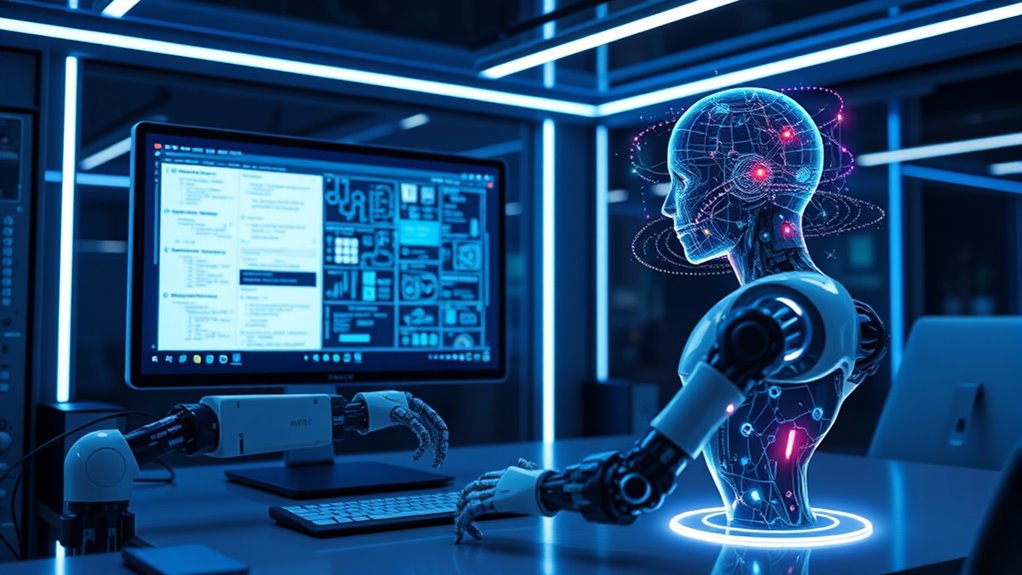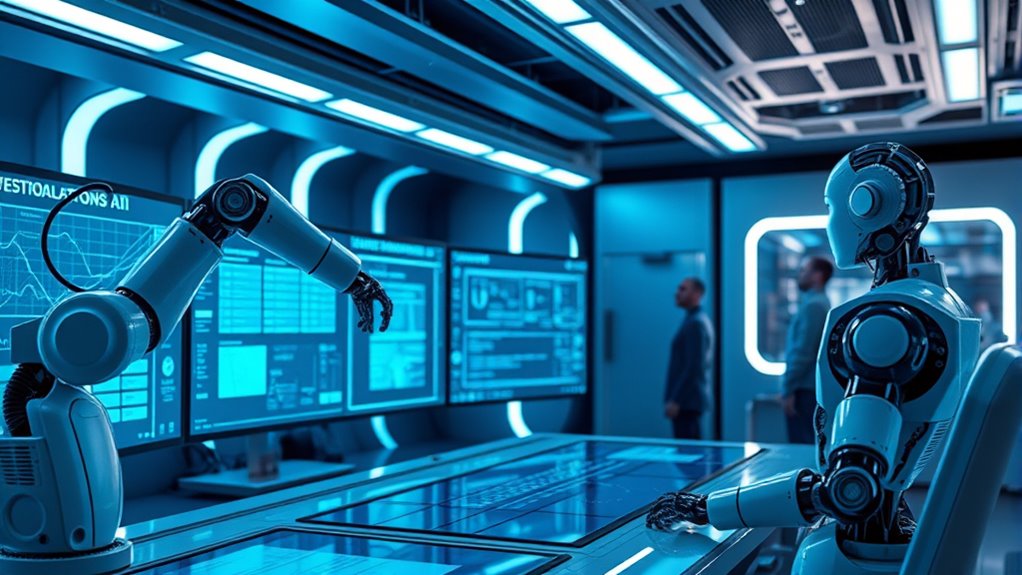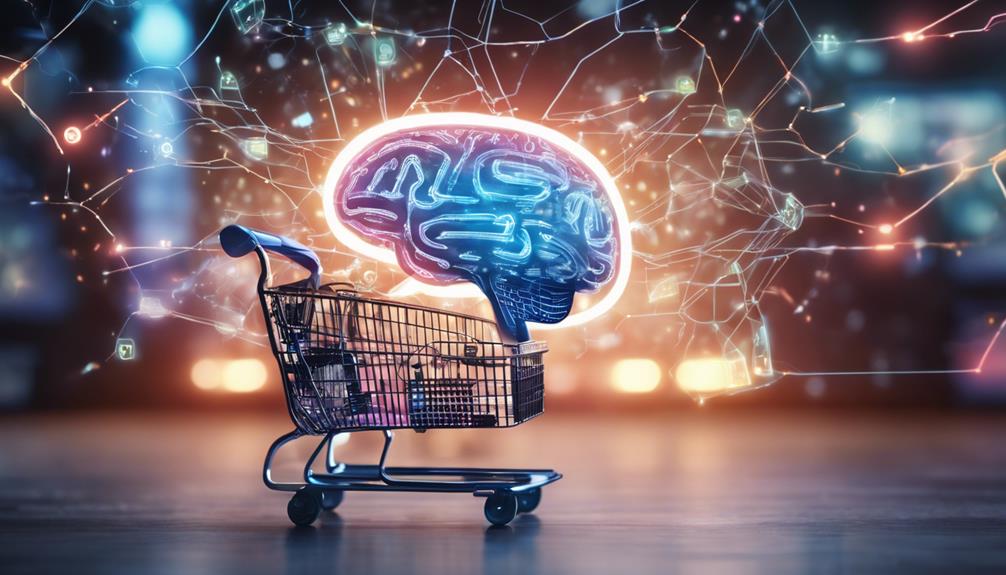By combining RPA with AI, you move beyond automating routine tasks to managing complex exceptions and changing workflows intelligently. This integration enables your systems to learn from data, recognize patterns, and adapt actions accordingly, reducing manual intervention and increasing agility. As your workflows become more resilient and responsive, you’ll handle surprises more effectively and optimize resources. Keep exploring how AI-enhanced automation can transform your operations with smarter, adaptive solutions.
Key Takeaways
- AI-enhanced RPA can identify and resolve process exceptions automatically, reducing manual intervention and increasing efficiency.
- Adaptive automation enables systems to learn from data, improving exception handling over time.
- Intelligent workflows interpret unstructured data and ambiguous situations for accurate decision-making.
- RPA combined with AI supports real-time anomaly detection and corrective actions within complex processes.
- Automating exceptions allows organizations to handle variability and complex scenarios more resiliently.

Robotic Process Automation (RPA) combined with Artificial Intelligence (AI) is transforming how businesses operate by enabling smarter, more efficient workflows. This powerful integration pushes beyond simple, rule-based tasks, creating intelligent workflows that adapt to changing circumstances. Instead of just automating routine activities, you’re now equipped to handle complex, exception-prone processes with ease. This is where adaptive automation comes into play—machines learn from data, recognize patterns, and adjust their actions accordingly, making your workflows more resilient and responsive.
AI-enhanced RPA enables adaptive, resilient workflows that learn and evolve with your business needs.
With intelligent workflows, you’re not limited to predefined scripts that only work under specific conditions. Instead, AI enhances RPA with decision-making capabilities, allowing your automation systems to evaluate situations and make real-time choices. For example, when processing invoices, the system can identify anomalies or discrepancies that deviate from standard patterns. It doesn’t just flag these exceptions; it can also suggest or execute appropriate corrective actions, reducing the need for human intervention. This makes your operations more agile and reduces bottlenecks caused by manual oversight.
Adaptive automation takes this a step further by enabling your RPA to learn from historical data and improve over time. You’re not just setting up automation and forgetting about it—you’re creating a dynamic process that evolves with your business needs. If a certain type of customer query becomes more frequent, the system recognizes this trend and adjusts its workflow accordingly, ensuring faster resolutions. This continuous learning process helps you stay ahead of potential issues and optimize your resources, all while maintaining high accuracy.
In practical terms, integrating AI with RPA means you’re empowering your automation tools to handle exceptions that previously required human judgment. When faced with unstructured data or ambiguous scenarios, your intelligent automation can interpret context, understand language nuances, and make informed decisions. This capability is vital for industries like finance, healthcare, and customer service, where variability and complexity are the norms. Additionally, leveraging comprehensive training data ensures your AI components improve their decision-making accuracy over time.
Frequently Asked Questions
How Does RPA + AI Improve Overall Process Accuracy?
You enhance process accuracy by leveraging machine learning and data validation techniques. These tools identify errors and inconsistencies in real-time, reducing human oversight mistakes. When you combine RPA with AI, it learns from previous data, refining its decision-making over time. This continuous improvement guarantees more precise outcomes, minimizes errors, and boosts overall process reliability, making your workflows smarter and more dependable.
What Industries Benefit Most From Automating Exceptions?
You’ll find that automating exceptions benefits industries facing industry-specific challenges and strict compliance considerations. For example, finance and healthcare deal with complex regulations, making manual exception handling error-prone. By automating these exceptions, you reduce risks, improve accuracy, and guarantee compliance. Retail and manufacturing also gain efficiencies by swiftly addressing unique cases, ultimately streamlining operations while adhering to industry standards and overcoming specific challenges.
How Do Businesses Handle AI Decision-Making Transparency?
You handle AI decision-making transparency by prioritizing algorithmic transparency, ensuring you understand how AI reaches its conclusions. You also consider ethical considerations, making sure decisions align with moral standards and avoid bias. By documenting AI processes and engaging stakeholders, you foster trust and accountability. This approach helps you build responsible AI systems, where decision-making is clear, fair, and compliant with regulations.
What Are the Initial Costs for Implementing RPA + AI?
When considering the initial costs for RPA and AI, you should conduct a thorough cost analysis to understand expenses like software licenses, hardware, and training. Be aware of implementation challenges such as integration complexity and process changes that can add unforeseen costs. While upfront investments might seem high, proper planning helps you manage expenses and guarantees smoother adoption, ultimately delivering better ROI and efficiency gains.
How Is Employee Adaptation Facilitated During Automation Transitions?
Like guiding a ship through changing tides, you can facilitate employee adaptation by embracing change management and workforce training. You should communicate clearly, involve staff early, and provide ongoing support. Offering hands-on training helps them understand new processes, easing fears of automation. Engaging employees in the transition process makes them feel valued, encouraging a smoother shift and fostering a positive attitude toward automation’s benefits.
Conclusion
By combining RPA and AI, you’re not just automating routine tasks—you’re transforming how you handle exceptions. Did you know that 60% of automation projects struggle with unstructured data and complex scenarios? Integrating AI helps you tackle these challenges head-on, making your processes smarter and more resilient. So, embrace this powerful duo to streamline operations, reduce errors, and stay ahead in today’s fast-paced landscape. The future of automation is here—are you ready to lead?









